The Serious Eats Tomato Shopping Guide
There are few things better than a ripe, juicy tomato right off the vine. Eaten raw, sliced for sandwiches, whizzed into a simple summer gazpacho, tossed into an herbaceous salad, or simmered into savory jam, the tomato is versatile and vibrantly flavorful—at least when it's in season.

And when that season arrives, it does so with what feels like reckless abandon—it's a mad dash to enjoy them while you can, and to find time to preserve more for later. As Deborah Madison puts it in her cookbook Local Flavors: Cooking and Eating from America's Farmers' Markets, "When it comes to taste and pleasure, the gap between locally grown tomato in summer and a long-distance tomato the rest of the year is enormous." Naturally, some varieties are better for snacking and for eating right away; others are best suited for sauces, roasting, and stews. (You can even freeze tomatoes, though we recommend cooking them first for optimal flavor and texture.)
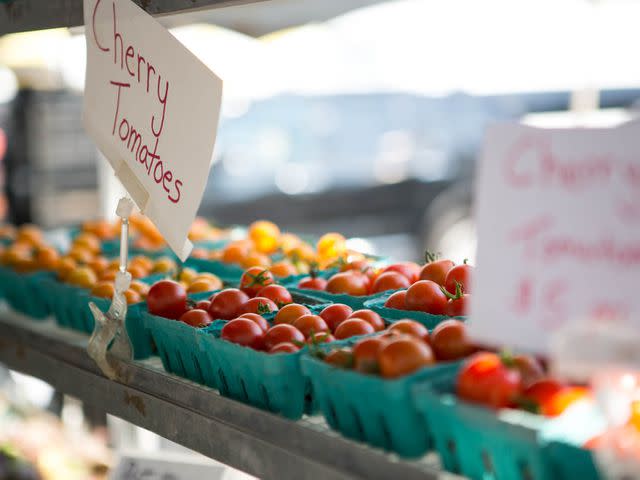
Most of the tomatoes we encounter in the supermarket are high yield strains, harvested when "mature green," which means that fruit has developed enough to support continued maturation once it's off the vine, but not so much that they'll bruise easily or rot during shipping (mainly from Florida, California, and Mexico).
Picking "mature green" is the optimal way for growers to transport massive amounts of fruit so that there's always a supply, 12 months out of the year, no matter where you live. But this approach rarely produces aromatic, flavorful tomatoes—that's why we recommend growing them yourself or shopping at your local farmers market for the best flavor and texture. The one exception to this rule? The smaller the commercially grown tomato, the better it's likely to taste. That's because smaller fruit is less likely to bruise during transit, and is therefore allowed to stay on the vine longer, plucked when it has actually started to ripen.
There are lively debates every summer as to the best way to store those tomatoes once you've got 'em. But the conventional wisdom about keeping them out of the refrigerator may not be as accurate as you might think (seriously, we put it to the test...over and over and over again).
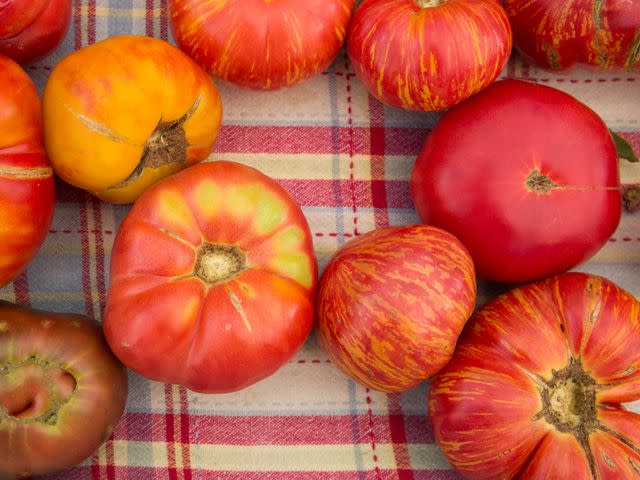
As for gardening? Tomatoes have two different growth habits and it's important to know which type you're planting. Otherwise, you may end up with tomatoes that take over your entire garden or a potted fire escape tomato plant that becomes unwieldy. The first type is called "indeterminate," meaning vining plants that grow tall, sometimes eight to 10 feet, and need support. These guys yield fruit continuously throughout the season and can keep on going as long as good growing conditions persist. The other type, known as determinate, exhibits a more compact, shrub-like growing pattern. These "bush" tomatoes tend to do well in containers and will stop growing once the top bud of the plant sets fruit.
But at the end of the day, genetically speaking, at least, tomatoes are either heirlooms or hybrids; here are the ones you should know, and the best ways to use them up while the season's at its peak.
Cherry Tomatoes
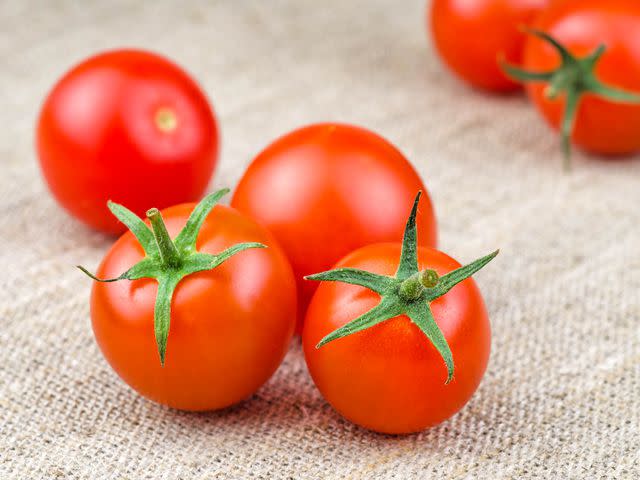
Among the smallest and, dare I say, cutest of cultivars, these round tomatoes are perfect for snacking, stuffing, or tossing in pasta, grain, or green salads. Then again, they're also excellent in cooked preparations, like compotes and sautés. Ranging in size from just about the tip of your thumb to a whole golf ball, you're most likely to encounter red ones, but it's possible to find yellow, green, and black varieties, too.
These are one of your most reliable grocery store choices—they're typically sweeter than their larger counterparts. The Super Sweet 100 is an especially popular red hybrid cultivar, but farmers markets sometimes sell Black Cherry tomatoes, which are really more of a reddish-purple akin to the color of red grapes. If you grow them yourself, watch out—given the right conditions, these indeterminate cherry tomato plants can take off like crazy.
Grape Tomatoes
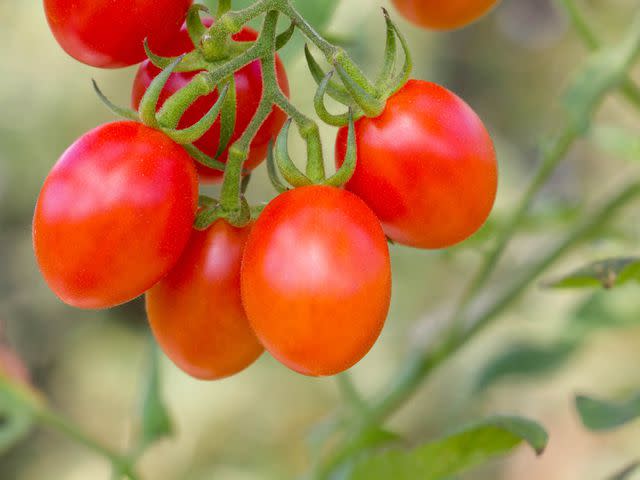
Teeny grape tomatoes have a more oblong shape, thicker skin, and lower water content than their cherry brethren. That lower moisture level is why these are such a reliable year-round supermarket staple: they ship and store remarkably well. Grape tomatoes hail from the plum tomato family, which is believed to originate in Southeast Asia. Some chefs gravitate to their small size, which is as perfect for a quick sauce as an appealing garnish. But they're just as great for snacking, roasting, or tossing into salads, too.
As for their place in your garden? They tend to ripen in clusters, perfect for those who want a large yield all at once.
Kumato Tomatoes
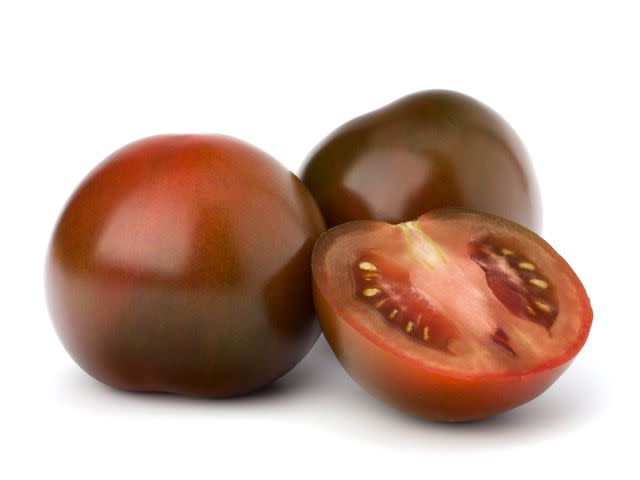
You've likely seen these brownish-red tomatoes in the supermarket, boxed in plastic and sold in one- or two-pound packages. The brainchild of Spanish scientists, Kumato is a trade name given to a patented non-GMO hybrid cultivar known in Spain as "Olmeca."
These maroon-hued tomatoes are available all year round. They're prized for their complex, sweet-tart flavor and relatively low water content. Kumatoes also exhibit a more vibrant, uniform color and impart a more tomato-like scent than many other commercial cultivars.
Campari Tomatoes and Tomatoes on the Vine
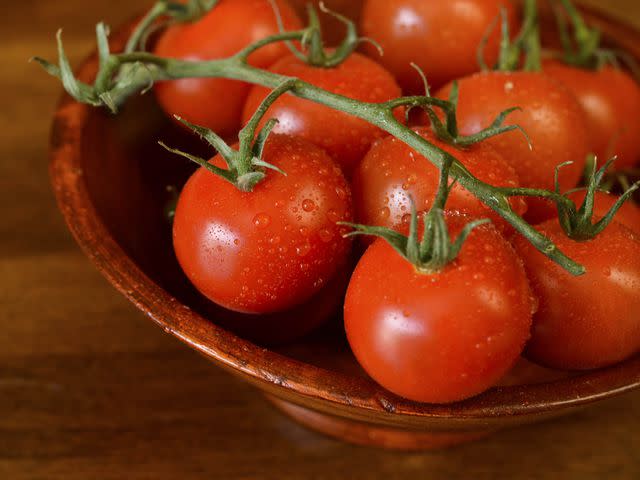
Campari is not technically a tomato on the vine, but a rather a cocktail tomato, despite the fact that you may see it sold in plastic clamshell containers with the vine still on. Campari tomatoes are globe-shaped, bigger than cherry tomatoes but smaller than your average tomato on the vine.
"Tomato on the vine," or "cluster tomatoes," on the other hand, are greenhouse-grown and typically sold in supermarkets in clumps of four to six fruits. The stems are intact, which gives the fruits a more pronounced tomato aroma, according to a USDA report on greenhouse tomatoes. That said, the name is a bit of misleading marketing: those tomatoes haven't really ripened on the vine, at least not to the point that you and I would consider "ripe." Like most supermarket tomatoes, they're shipped when they're still on the green side—technically, a tomato can receive the vine-ripened moniker so long as they' d are picked at what's called the "breaker" stage—when they're just beginning to show signs of changing color.
Beefsteak Tomatoes
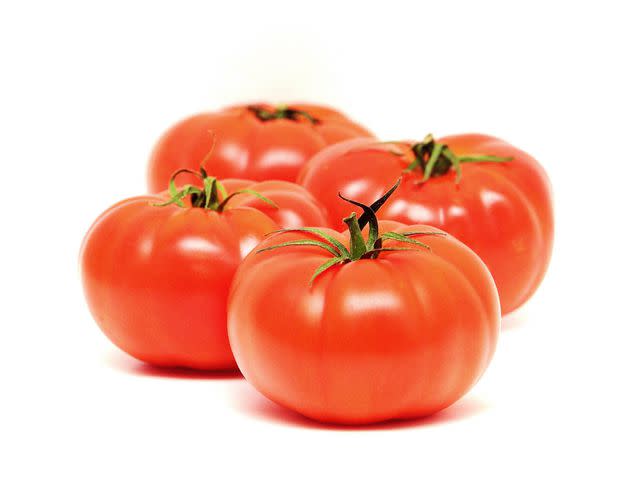
Here's a bit of trivia: while beefsteak is the common name for the large, baseball-sized tomatoes you'll find on your deli sandwich in the dead of winter, it's also a category referring to shape: Brandywines and Cherokee Purples are technically beefsteaks, too.
Fresh beefsteak tomatoes make me think of the tomatoes of my Jersey childhood. They smell like summer; warm, fragrant, and juicy. Beefsteaks hold up well to slicing—you can get them pretty thin—so one heavy tomato goes a long way. They're perfect on sandwiches like tomato, mayo, and toast or this lobster BLT. But out-of-season beefsteak tomatoes are a different matter entirely, almost always bland, mealy, anemic, and watery.
Roma Tomatoes
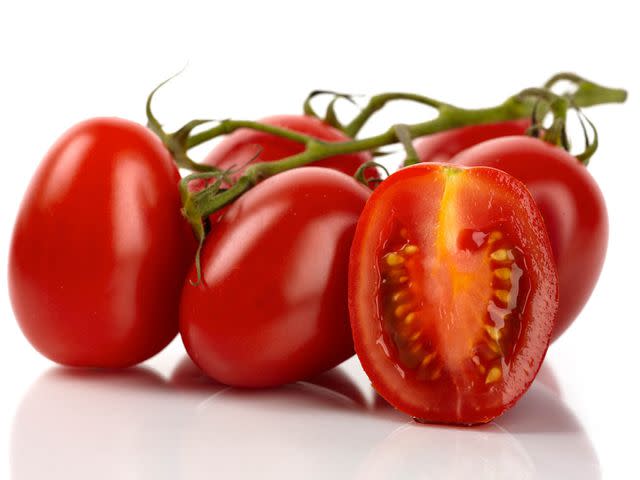
Roma tomatoes are the canning tomatoes of choice, thanks to their firm texture, slender shape, and low water content—they've got fewer locules, or seed compartments, than their round beefsteak counterparts. Fewer seeds means less waste and more fruit. They also happen to be prime candidates for container gardening—they're determinate growers that won't get too leggy.
Romas are also commonly referred to as plum tomatoes, paste tomatoes, or Italian plum tomatoes, and they're well-suited for thick, tomato-based sauces, whether used fresh or canned. (Fresh plum tomatoes are widely available at grocery stores, but they're also often what you'll find in canned tomatoes). In the industry, plums like Romas are referred to, broadly speaking, as "processing tomatoes."
Heirloom, Farmers Market, and Specialty Tomatoes
Sungold Tomatoes
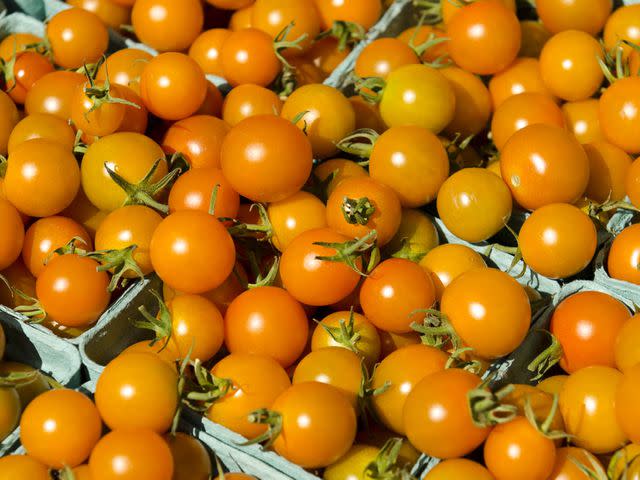
Sungolds are round cherry tomatoes that exhibit an orangey-gold color; the hybrid was introduced to British and American gardeners back in 1992. You may see them in grocery stores that stock produce from local farms, but Sungolds are the darling of the farmers market come late summer. They're the closest thing to nature's candy that you can possibly imagine, an enchanting balance of tangy and sweet flavors—heavy on the sweet. They find their way easily into salads, but I love them just for snacking, right out of hand. I find myself having to buy them twice a week.
They're so easy to grow that if you plant a few, you'll want to keep a diligent eye on them because they offer such high yields. Farmers like them, too, because they remain a bit more firm than the average cherry tomato, meaning they travel especially well. If you find yourself with a bumper crop, roast the tomatoes in salt, olive oil and a tiny bit of sugar: the juices ooze out and become caramelized. Keep them in your fridge in a jar for tossing into pasta, throwing into omelets, or topping a homemade pizza.
Yellow Pear Tomato
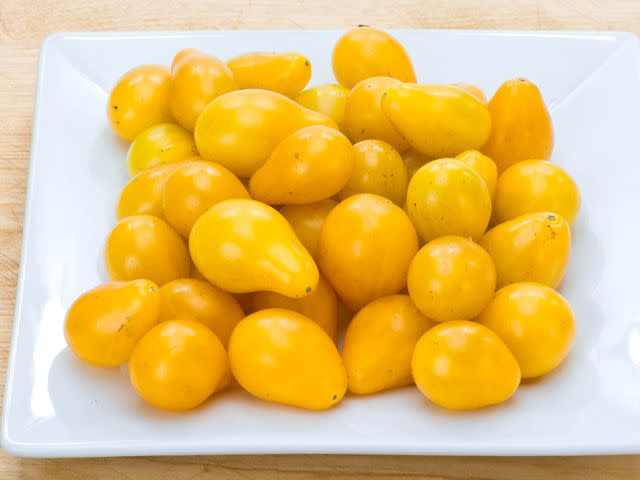
This tomato is what it sounds like: a yellow tomato shaped like a pear. The heirloom is known for its bite-sized shape and mild flavor. Unlike some of its more contemporary cousins, the pear cultivar dates back to 18th century Europe, and while other pear-shaped varieties are available (orange and red, namely) the yellow ones are the most common. It's one of the oldest tomatoes grown in the United States for mass consumption—I'm talking 1847 and the dawn of canning. The vines on this indeterminate growing tomato can get really leggy and grow fast, promising an abundance of fruit all summer long.
Brandywine Tomatoes
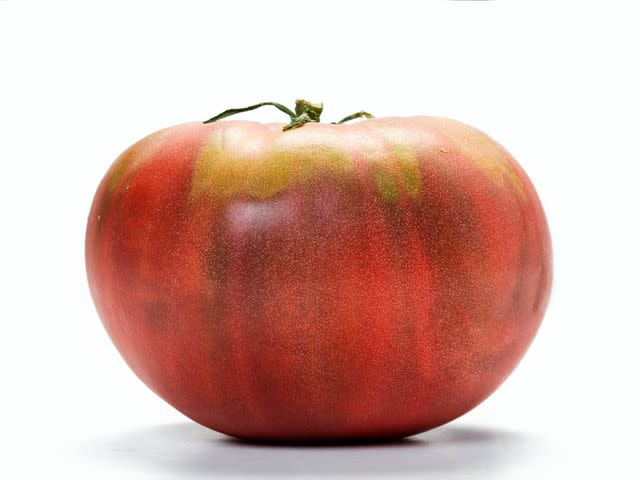
The Brandywine has become the poster child for farmers market heirloom tomatoes. The pinkish-red beefsteak is prized for its intensely meaty interior, sweet flavor, and well-balanced acidity. Brandywines are slow growing and minimal yielders, known for their potentially enormous size—they can swell to over a pound.
They work well cubed for panzanella or just tossed with other colorful tomatoes with fresh mozzarella and olive oil for a simple salad. Don't be alarmed if you see them sold with splits and deep grooves (known as "ribbed shoulders") and green spots (or "green shoulders") near the stem—it's not uncommon and the tomato's still perfectly good for eating.
Green Zebra Tomatoes
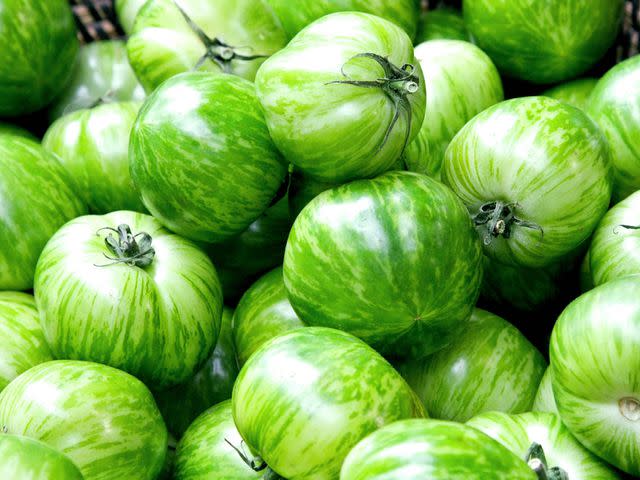
Lime green and striped lemon yellow, green zebras remain brightly acidic even when ripe. There's some debate about whether they're actually an heirloom cultivar—they were first bred in the early 1980s, so they're still relatively young. That being said, they're popular with chefs and food lovers and you'll usually find them grouped with heirlooms at farmers markets. Popularized by Alice Waters at Chez Panisse, green zebras make for a zippy, acidic green gazpacho.
Cherokee Purple
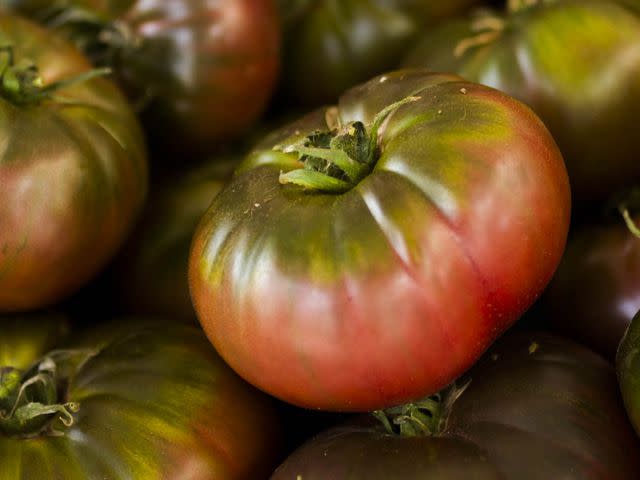
Here's another substantial tomato, an heirloom beefsteak with reddish-purple, almost mahogany-colored flesh and a sweet, rich flavor. The Cherokee purple is revered for its dense, juicy texture, and a dark interior with small seeds, which are surrounded by a green gel and scattered throughout the fruit. The large tomatoes work well in salads, sliced thinly for a BLT or burger, or used for canning and dehydrating. Like Brandywines, they're prone to irregular shapes—some call them downright ugly—and sometimes their skin will split.
Scientist Craig LeHoullier, author of Epic Tomatoes: How to Select and Grow the Best Varieties of All Time, was recognized by Slow Food USA for rediscovering and preserving the variety. He credits the heirloom to the Cherokee people, and received the seeds in the mail from a man in Tennessee who said he believed they dated back 100 years.
Garden Peach Tomatoes
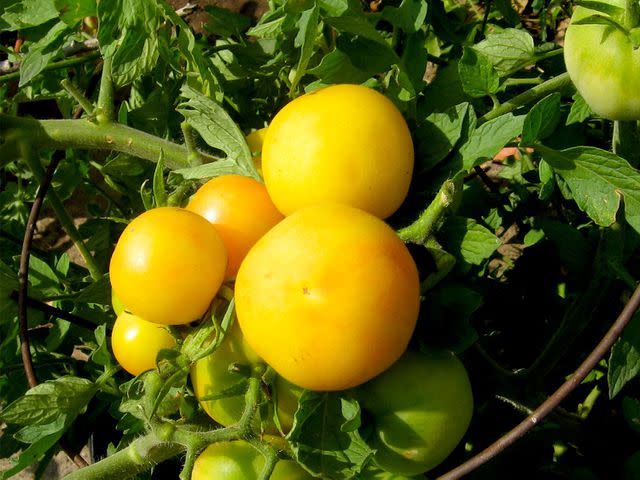
Like their namesake, these sweet but mild heirloom tomatoes sport a coating of fuzz. And there's no missing the peachy glow on the yellow skin, with a faint blush of pale pink that appears across the flesh when they're ripe. If they're sold as part of an heirloom mix at the farmers market, peach tomatoes should be the ones you eat quickly, because the delicate fruit won't make it as long as some of their heavier, meatier counterparts. They don't get too large, typically; chop them up for salads or just sprinkle them with salt.
San Marzano
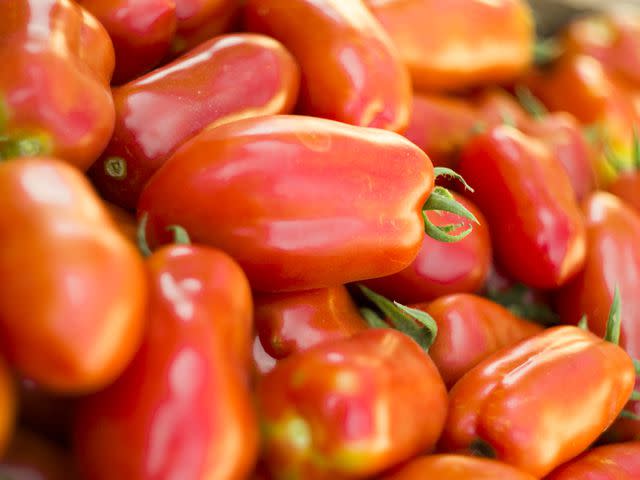
Native to the volcanic soils in the shade of Mount Vesuvius in Italy, San Marzanos tomatoes are prized by chefs for their meaty texture and easy-to-peel skin. Marked with a little x at the bottom, blanched, and peeled, it makes for quick skinless fruit best-suited for pastas and sauces. San Marzanos are less watery and goopy than other tomatoes so there's very little waste. In winter months, when decent fresh tomatoes are nowhere to be found, canned imported San Marzanos are the tomato of choice for homemade sauce.
This particular variety is also well-suited for oven drying and roasting because of its texture; there's much more concentrated tomato flavor because there's simply more tomato meat to go around. (Psst: Oven-dried tomatoes are great for a snack, or lovely sprinkled with thyme and for infusing olive oil.)
San Marzanos aren't a widely grown cultivar, but you can purchase seeds or plants and grow them yourself. That said, purists will argue that the taste just ain't the same without the volcanic soil; for the real deal, make sure they indicate "D.O.P." (loosely translated as "protected designation of origin). If you do decide to grow them at home, be forewarned that they're a vining plant, and can reach six to eight feet or taller depending on growing conditions. They will need some serious staking or caging to keep them supported as they continue to produce fruit.
Read the original article on Serious Eats.

